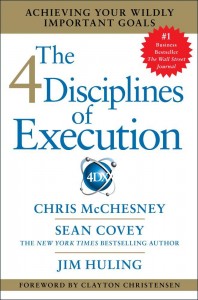4 Disciplines of Execution
In every business, strategy is vital for success. It charts the course and sets the direction. But, every strategist knows that so often strategic goals never take off because they are drowned by all of the other competing interests. The daily activities of the organization starve the strategic goal. In The 4 Disciplines of Execution, a terrific new book, authors Chris McChesney, Sean Covey and Jim Huling explain how learning four disciplines can help produce breakthrough results.
And these same concepts can be applied to achieve your personal goals.
After reading the book, I followed up with author Jim Huling to delve into the material.
Jim, for those who aren’t familiar with the four disciplines, would you walk us through them quickly?
- Discipline 1: The discipline of focus. Extraordinary results can only be achieved when you are clear about what matters most. As simple as this principle may sound, few leaders ever master it. 4DX teaches why focus is so critical and how to overcome your biggest source of resistance.
- Discipline 2: The discipline of leverage. With unlimited time and resources, you could accomplish anything. Unfortunately, your challenge is usually the opposite: accomplish more with less. 4DX shows leaders where they can find real leverage and how to use it to produce extraordinary results.
- Discipline 3: The discipline of engagement. You have the authority to make things happen, but you want more than that – you want the performance that only passion and engagement can produce. 4DX enables leaders to rise from authority-driven compliance to passion-driven commitment in themselves and the people they lead.
- Discipline 4: The discipline of accountability. No matter how brilliant your plan or how important your goal, nothing will happen until you follow through with consistent action. 4DX brings the practices that drive accountability and follow through, despite a whirlwind of competing priorities.
The Distraction of the Whirlwind
I love the “Whirlwind” concept because we all have experienced it, but haven’t labeled it before. Tell me about the whirlwind and what can be done about it.
One of the most important revelations we’ve had is that the real enemy of execution is your day job! We call it the whirlwind. It’s the massive amount of energy that’s necessary just to keep your operation going on a day-to-day basis; and, ironically, it’s also the thing that makes it so hard to execute anything new.
Think about it this way: While you’re reading these words, are you being distracted by incoming emails, a ringing phone, or the person standing in your office door? The whirlwind is urgent and it acts on you and everyone working for you every minute of every day. The goals you’ve set for moving forward are important, but when urgency and importance clash, urgency will win every time.
The best way to understand the whirlwind is to remember the last important initiative in your organization that launched well and then died. How did the end come? Was it with a loud crash and a tremendous explosion? Or did it go down quietly over time, suffocated by the whirlwind? We’ve asked thousands of leaders this question and we always get the same answer: “Slow suffocation.”
Executing in spite of the whirlwind means overcoming not only its powerful distraction, but also the inertia of “the way it’s always been done.” If you ignore the urgent, it can kill you today. It’s also true, however, that if you ignore the important, it can kill you tomorrow. In other words, if you and your team operate solely from within the whirlwind, you won’t progress—all your energy is spent just trying to stay upright in the wind. The challenge is executing your most important goals in the midst of the urgent!
If you ignore the urgent, it can kill you today. It’s also true, however, that if you ignore the important, it can kill you tomorrow.
You talk about the leadership challenge of focus. Why is focus such an ongoing challenge?
Basically, the more you try to do, the less you actually accomplish. This is a stark, inescapable principle that we all live with. Somewhere along the way, most leaders forget this. Why? Because smart, ambitious leaders don’t want to do less, they want to do more, even when they know better. Isn’t it really difficult for you to say no to a good idea, much less a great one? And yet, there will always be more good ideas than you and your team have the capacity to execute. That’s why your first challenge is focusing on the wildly important.
Focus is a natural principle. The sun’s scattered rays are too weak to start a fire, but once you focus them with a magnifying glass they will bring paper to flame in seconds. The same is true of human beings—once their collective energy is focused on a challenge, there is little they can’t accomplish.
Discipline 1: Focus on the wildly important requires you to go against your basic wiring as a leader and focus on less so that your team can achieve more.
You talk about WIGs (Wildly Important Goals). What are some of the difficulties in executing a WIG?
Execution starts with focus. Without it, the other three disciplines won’t be able to help you. So, why do almost all leaders struggle to narrow their focus? It’s not because they don’t think focus is needed. Every week, we work with dozens of leadership teams across the world and, almost without exception, they acknowledge that they need greater focus. Despite this desire, they continue to find themselves with too many competing priorities, pulling their teams in too many different directions.
Focusing on the wildly important means narrowing the number of goals you are attempting to accomplish beyond the day-to-day demands of your whirlwind.
Simply put, Discipline 1 is about applying more energy against fewer goals because, when it comes to setting goals, the law of diminishing returns is as real as the law of gravity.
If a team focuses on two or even three goals beyond the demands of their whirlwind, they can often accomplish them. However, if they set four to ten goals, our experience has been that they will achieve only one or two. They’ll be going backward! If they go after eleven to twenty goals in addition to the whirlwind, they’ll lose all focus. Confronted with so many goals the team members will stop listening let alone executing.
The fundamental principle at work in Discipline 1 is that human beings are genetically hardwired to do one thing at a time with excellence. Science tells us the human brain can give full focus to only a single object at any given moment. You can’t even give your best effort to driving a car while talking on a mobile phone and eating a burger, let alone juggle multiple important business goals at once.
I’ve seen the power of a scorecard and the impact on results. From sales goals to employee safety, it makes a difference. You talk about keeping a compelling scoreboard under Discipline 3. What are some of the pitfalls leaders fall into when trying to install a scoreboard?
Visually displaying data is not new to you or your team. In fact, you may be thinking that you already have a scoreboard, or even lots of scoreboards, all captured in complex spreadsheets inside your computer. And the data just keeps coming in. Most of this data is in the form of lag measures accompanied by historical trends, forward projections, and detailed financial analysis. The data is important and it serves a purpose for you as the leader; your spreadsheets are what we would call a coach’s scoreboard. But what we’re after in Discipline 3 is something quite different. In implementing Discipline 3, you and your team need to build a players’ scoreboard, one that’s designed solely to engage the players on your team to win.
There are four questions we always ask when determining if a scoreboard is likely to be compelling to the players:
- Is it simple?
- Can I see it easily?
- Does it show lead and lag measures?
- Can I tell at a glance if I’m winning?


